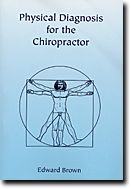








| |
|
|
|
|
| |
|
|
|
|
|
| Dynamic Chiropractic December 16, 2004, Volume 22, Issue 26 |
Printer Friendly Version E-mail to a Friend |
|
|
|||||||||||||||
| Title: | Physical Diagnosis for the Chiropractor |
| Author: | Edward Brown, DC, DABCI |
| Type: | Paperback, 295 pages |
| Price: | $34.95 |
| Part #: | T-265 |

The students in Dr. Brown's class at Parker College may not know how lucky they are, but if this book is any indication, they are fortunate, indeed. Under normal circumstances, one doesn't get excited about a diagnosis manual, but this book is different. It is a gem from which anyone could benefit. The nature of the material is very condensed, and even though it is a handbook, it is comprehensive. There are few diagrams and virtually no photos.
Drs. Sarnat and Winterstein, with their Illinois Blue Cross/Blue Shield HMO project that utilized chiropractors as primary care providers [www.chiroweb.com/archives/22/18/16.html], permanently changed the health care paradigm. Using DCs as drugless primary care providers, costs were cut 50 percent while patient satisfaction increased. Well over 90 percent of the chiropractic diagnoses in that study were considered accurate by the secondary specialists. In the new millennium, chiropractic is often the first place patients turn, and more is expected of us than ever. Dr. Brown is on the cusp of the future. His work is succinct, organized and clever, and will go a long way in helping practitioners handle the additional responsibility coming our way.
This text is a combination of information from The Merck Manual, the Natural Healing Encyclopedia, and a diagnostic book, along with many of the author's own excellent insights and explanations. It encourages low-tech screening exams. Frequently, the only equipment necessary is the practitioner's own body. That is the method used for peripheral vision - comparing your own eyesight to your patient's visual field. Dr. Brown uses a hearing test that only requires rubbing your fingers together while comparing the right and left ears. Recently, its effectiveness was demonstrated when a patient regained hearing after his adjustment.
If knowledge is power, this book will make the chiropractor a commanding presence. The author makes the case for heart rate variability (HRV) as the earliest predictor of heart disease - even better than stress ECGs. This consists of objective measurement of inspiration, which speeds up heartbeats, and exhalation, which slows them down. This is at least partially dependent on nerve supply, so chiropractic may be one of the most relevant prophylactic therapies for coronary problems.
The following clinical gems will give you a taste of what's in store for the reader:
Hopefully, you are getting the picture that this book is worthwhile reading; in fact, it is valuable reading for literally the rest of your professional life.
There are hundred, if not thousands of other observations in this book, any of which might seriously impact a patient's life - but this is only a book review. For the complete experience, you have to personally experience Dr. Brown's course. This book does have study guide objectives at the end of every chapter, which is kind of a mini-course. As an aside, you should read the questions first so you assimilate the information more diligently. In this day of multimedia, the author should consider an addendum CD that illustrates many of the conditions and techniques. It would make a great accompaniment, although he does note many Web addresses.
This book gets my highest recommendation; it is for chiropractors with an interest in increasing their diagnostic acumen. Since I started reviewing books, I have found a handful of chiropractic texts that are virtually indispensable. This book belongs in that stellar classification.
Dr. Lavitan's Rating:
10 out of 10

| Dynamic Chiropractic December 16, 2004, Volume 22, Issue 26 |
Printer Friendly Version E-mail to a Friend |
|
To report inappropriate ads, |